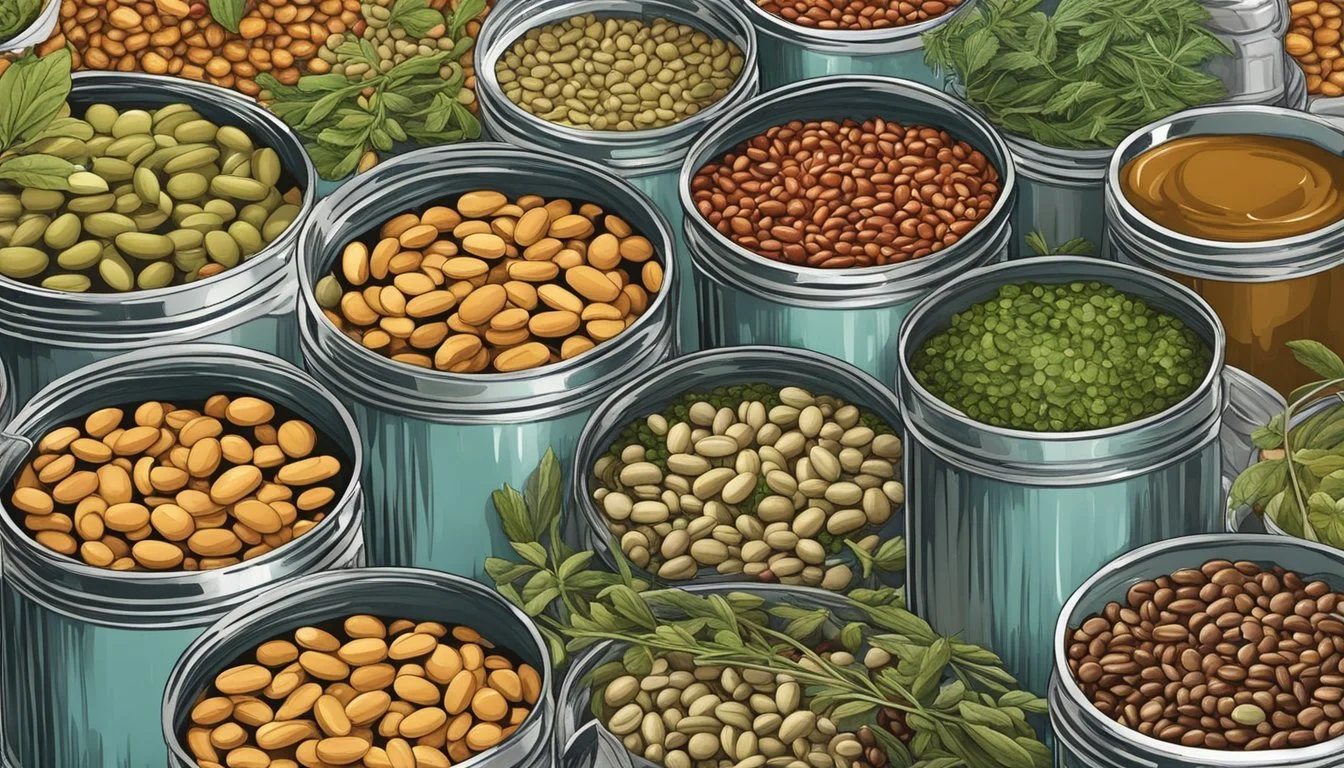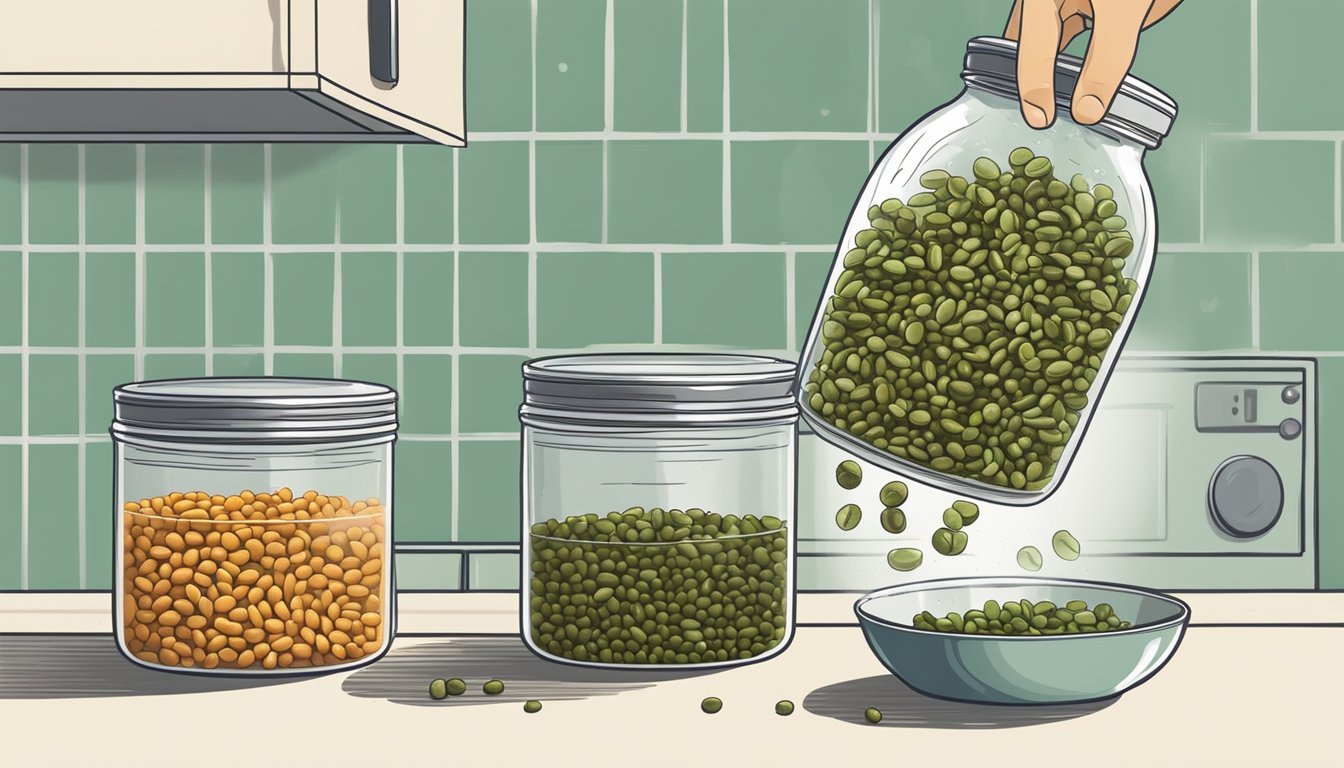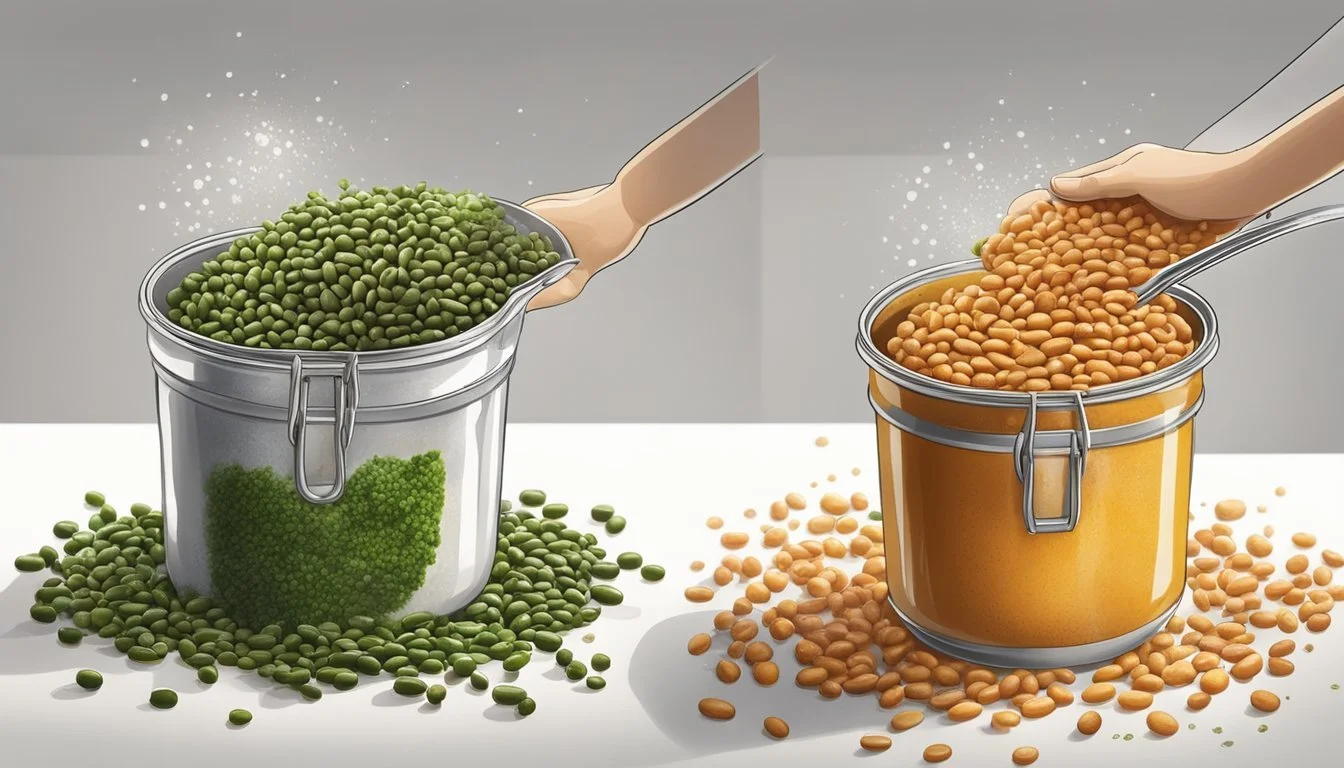Fixing Overly Salty Canned Beans
Mastering Rinsing and Seasoning Adjustments
Canned beans are a staple in many pantries due to their convenience and nutritional value. However, they often come with a high sodium content, which can lead to overly salty dishes that overshadow their health benefits. Overconsumption of sodium poses health risks, making it important for consumers to find ways to mitigate this issue.
The process of fixing salty canned beans is straightforward and effective. It begins by addressing the excess sodium on the surface of the beans through rinsing, a simple yet crucial step. This technique involves draining the beans and washing them under cold water. This action effectively removes some of the brine in which the beans were preserved, thereby reducing their overall saltiness.
Alongside rinsing, seasoning adjustments can further refine the flavor balance. Introducing additional ingredients that counteract saltiness without increasing sodium levels can transform a dish. Commonly used additives include acids such as vinegar or lemon juice, as well as sweet components like sugar or honey. These ingredients complement the beans while enhancing the taste, providing an appealing solution to an otherwise sodium-laden meal.
Understanding Salinity in Canned Beans
Canned beans are a convenient food staple, yet their salinity levels can be cause for concern due to health implications and taste preferences. It is essential to comprehend the preservation role of salt and the potential health effects of high sodium content.
The Role of Salt in Preserving Beans
Salt is a critical component in preserving canned beans. It acts as a natural preservative by inhibiting the growth of bacteria, yeast, and mold. During the canning process, beans are cooked and then sealed within an airtight container—in this case, a can—with a liquid that often contains a high amount of salt. This saline liquid helps to ensure that the beans remain safe to eat for an extended period. Salt also aids in maintaining the texture and flavor of the beans during storage.
Effect of Salt on Bean Preservation:
Inhibition: Salt creates an environment where harmful microorganisms cannot thrive.
Flavor maintenance: Salinity enhances the taste and palatability of preserved beans.
Texture preservation: By osmosis, salt helps beans retain their firmness.
Health Implications of High Sodium
A diet high in sodium can lead to various health issues, including hypertension, which is a major risk factor for heart disease and stroke. Many people consume more sodium than the recommended daily intake, and canned beans can be a significant source of this sodium.
Relevant Health Considerations:
Blood pressure: Excessive sodium intake can cause an increase in blood pressure.
Nutrition: Canned beans have nutritional benefits, but their high sodium content can detract from these.
Daily intake limits: Health organizations stipulate an advised limit on sodium intake to minimize health risks.
Consumers seeking to reduce their sodium intake should pay close attention to labels and preparation methods when selecting and consuming canned beans. Rinsing the beans thoroughly can help remove some of the excess salt, thereby making them a healthier component of one's diet.
Initial Steps to Reduce Saltiness
Reducing the saltiness of canned beans begins with simple yet effective kitchen techniques. These methods aim to remove excess salt and prepare the beans for further cooking or consumption.
Draining and Rinsing Techniques
One should start by draining the salty brine from the can of beans. Afterwards, placing the beans in a colander under cold, running water and rinsing them thoroughly for at least 30 seconds to 60 seconds can significantly reduce their saltiness.
Strategic Soaking
For a more in-depth desalination, they can soak the beans after rinsing. Submerging the beans in a bowl of clean water for a prolonged period, typically overnight or a minimum of 8 hours, helps to draw out the salt. The beans should be drained and rinsed again post-soak before cooking.
Using Unsalted Water for Cooking
When it comes time to cook the beans, using fresh, unsalted water is key. This ensures that no additional salt is added to the beans and allows for a slower reabsorption of liquid, thus further diluting any residual saltiness.
By following these initial steps, one can effectively reduce the saltiness in canned beans, ensuring they are palatable and ready for incorporation into a variety of dishes.
Cooking Methods to Adjust Salt Levels
When dealing with overly salty canned beans, certain cooking methods can be employed effectively to adjust salt levels without compromising flavor or texture.
Boiling With Unsalted Liquid
One can boil the beans in a pot of unsalted liquid, such as water or unsalted broth. Boiling allows for excess salt to leach out into the cooking liquid. The cook must be attentive, taste testing occasionally, to ensure that the beans do not become overly diluted and maintain their desired flavor profile.
Soaking and Simmering
Soaking beans overnight is a traditional method that can also apply to reducing saltiness quickly. After rinsing the beans thoroughly to remove surface salt, they should be submerged in a bowl of cold water for an extended period, ideally overnight. After soaking, they need simmering over low heat, which gives the cook control over the seasoning process and avoid further degradation of texture.
Additional Cooking After Rinsing
Once the cook has rinsed the beans to remove the saline solution from the canning process, additional cooking such as incorporating them into a larger dish can also help. Unsalty ingredients added to the dish, such as vegetables, grains, or unsalted stocks, can absorb some of the salinity and redistribute the flavors throughout the dish, creating a balanced end result.
Balancing Flavors to Counteract Saltiness
When canned beans are overly salty, the key to rebalancing the dish lies in integrating complementary flavors. Acids, sweeteners, or herbs and spices can significantly adjust the flavor profile, effectively masking the saltiness and rendering the dish more palatable.
Incorporating Acids
Acidic components can greatly enhance the taste of a dish by cutting through the salt. Here are specific tactics:
Add lemon juice: A squeeze of lemon adds brightness and can significantly reduce perceived saltiness.
Utilize vinegar: A small amount of vinegar can also counteract excess salt and add a new flavor dimension.
Using Sweeteners
Sweetness opposes saltiness and can create a more balanced flavor. Options include:
Sugar: A pinch of sugar might offset the salty taste.
Natural sweeteners: Honey or maple syrup are natural alternatives that can similarly counterbalance saltiness.
Enhancing with Herbs and Spices
Lastly, the use of herbs and spices delivers a layered complexity to dishes that can divert attention from saltiness.
Herbs: Fresh herbs such as parsley or cilantro can freshen the overall taste.
Spices: A carefully selected spice, such as cumin or paprika, can add depth that may make the salt less dominant.
Recipe Adjustments for Over-Salted Beans
When faced with the challenge of over-salted canned beans, one has several options to remedy the situation. These techniques involve careful modification of the recipe to restore balance to the dish.
Altering the Bean to Liquid Ratio
To reduce the salt concentration in beans, one should consider increasing the amount of liquid. This can be done by adding water, unsalted stock, or broth, which will dilute the overall saltiness. The key steps are:
Pour additional unsalted liquid into the pot containing the beans.
Simmer the mixture for a few minutes to allow the flavors to meld.
It's critical to taste periodically and stop once the desired balance is achieved.
Amending Recipes with Additional Ingredients
Introducing new components can offset excess salt. Here are specific ways to adjust the recipe:
Incorporate cream: A dollop of cream can enrich the beans and mellow out the saltiness.
Mix in unsalted sauce or stock: This can introduce new flavors and reduce salt.
Add cooked, unsalted beans: They can help balance the salt concentration.
One should add these in small quantities, tasting and adjusting the seasoning as required.
Choosing Complementary Dish Pairings
Pairing over-salted beans with other dishes can help neutralize the taste. One can:
Serve the salty beans alongside starch-based dishes like rice or potatoes, which can absorb some of the salt.
Use the beans as part of a larger casserole or salad where their saltiness will be diffused among other ingredients.
By carefully selecting complementary dishes, one can turn a mishap into an element of a delicious meal.
Creative Solutions and Fixes
When canned beans turn out too salty, there are a variety of tactics to mitigate the salinity and ensure a palatable dish. These strategies include leveraging the absorbing power of certain ingredients, diluting the salty flavor across a larger batch of food, or selectively removing and substituting elements of the dish.
Potato Trick: Fact or Myth?
The idea that a potato can absorb excess salt from a dish like soup or chili is often circulated among home cooks. Although potatoes contain starch which can absorb some flavors and liquid, the effectiveness in specifically targeting and removing salt is largely overstated. The potato may absorb some salty liquid, but it does not function as a sponge for salt specifically. If someone chooses to use this method, it's important that they peel the potato to maximize any potential absorption and later remove it before serving.
Batch Cooking to Correct Salinity
A reliable method to adjust the salt level in a dish with salty beans is to dilute the salinity across a larger batch. If the beans are intended for a dish like chili, the cook can prepare a second batch without added salt and combine it with the salty one. This will distribute the salt more evenly and can bring the overall taste into balance.
Example for soup:
1 part salty beans : 1 part unsalted stock and vegetables
Result: A doubled batch with balanced seasoning
Selective Removal and Replacement
In some cases, the best approach is to rinse the excess salt away from the beans under cold water. This method directly removes some of the surface salt content. If the beans are part of a more complex dish, the cook may selectively remove the salty component, rinse it, and then return it to the dish. Addition of extra ingredients that can counterbalance the salt, such as sugar or acid, should be done with a cautious hand to avoid over-seasoning.
Rinsing technique:
Step 1: Remove beans, rinse thoroughly.
Step 2: Taste, and if necessary, replace some of the liquid with unsalted stock or water.
Long-Term Strategies to Avoid Over-Salting
In the journey to reduce sodium intake and prepare healthier meals with canned beans, one must adopt sustainable practices. These practices ensure that the salting process enhances the flavor without compromising the nutritional value of the beans.
Understanding Salting Stages
Cooking with canned beans typically involves various stage where salt can be added: during canning, cooking, or at the table. To avoid over-salting, individuals should be aware of the salinity at each stage. Canned beans often come with added salt; this should be taken into account when adding salt during meal preparation. It is advisable to add salt in increments and to taste the beans at each stage of cooking.
Choosing Low-Sodium Bean Varieties
When purchasing canned beans, opting for low-sodium or no-saltadded varieties is a proactive step towards controlling salt intake. The nutrition labels should always be checked to compare sodium levels between brands. A table may help to clearly illustrate a comparison:
Brand Sodium Content Notes Brand A 240 mg No added salt Brand B 480 mg Reduced sodium Brand C 390 mg Regular
Health-conscious consumers will find that no-salt-added beans offer more control over the final salt content of the meal.
Taste Testing and Adjustment Techniques
The cook's best tool is their taste buds. Regular taste testing during cooking can help detect the salinity of a dish before it becomes overly salty. When preparing a meal, one should initially use only a small amount of salt and incrementally add more only if necessary. Additionally, taste testing by multiple individuals can offer diverse perspectives on the saltiness, ensuring a balanced dish for all. If the beans are too salty, rinsing them in unsalted liquid can help reduce the sodium content before they are added to the meal.
Conclusion: Empowering Healthy and Flavorful Choices
Managing the sodium content in canned beans not only aligns with healthy eating practices but also allows culinary enthusiasts to have control over the flavor of their meals. Consumers can significantly reduce the saltiness of canned beans by implementing simple rinsing procedures.
Rinsing Techniques:
Drain: Discard the canning liquid.
Rinse: Wash the beans under cold running water.
Not only does this step wash away excess sodium, it can also remove some of the compounds that may contribute to digestive discomfort, thus enhancing the overall healthfulness of the beans.
Seasoning adjustments are also paramount for both flavor and health considerations:
Balancing Flavors:
Sweetness: Add a touch of honey or sugar to counteract saltiness.
Acidity: Introduce vinegar or lemon juice for a flavor lift.
Herbs & Spices: Enlist the help of garlic, onion, celery, or dried herbs to enhance depth of flavor without resorting to salt.
By being mindful of sodium intake and opting for these seasoning techniques, individuals can enjoy more wholesome and appealing meals.
They present a template for anyone aiming to make nutritional choices without sacrificing the enjoyment of a flavorful and satisfying meal. Moderating the salt content in canned beans is a straightforward way to contribute to a balanced diet.






